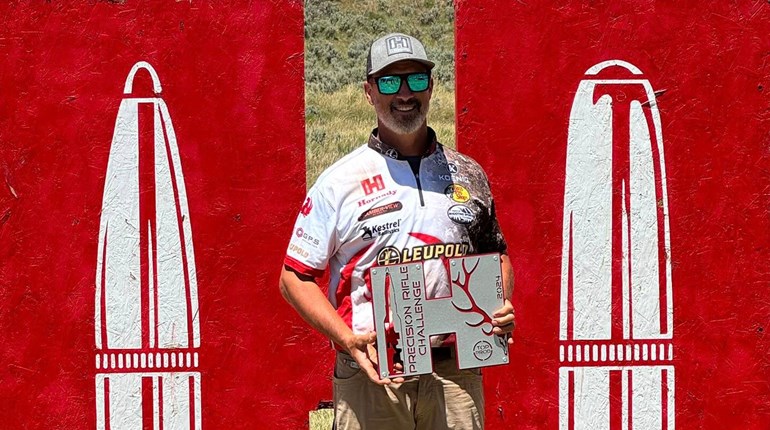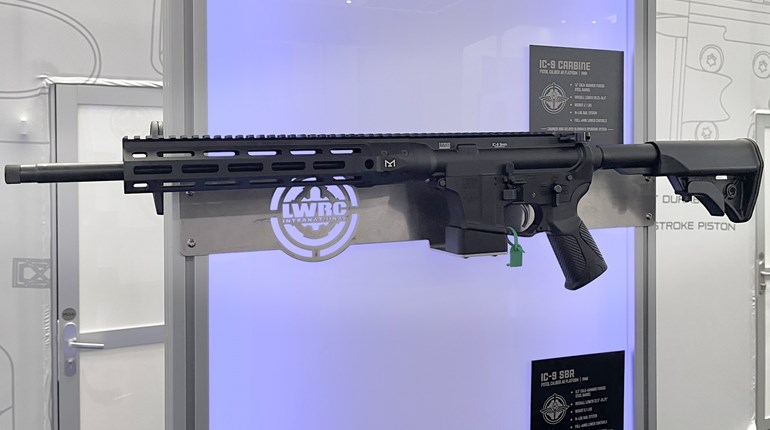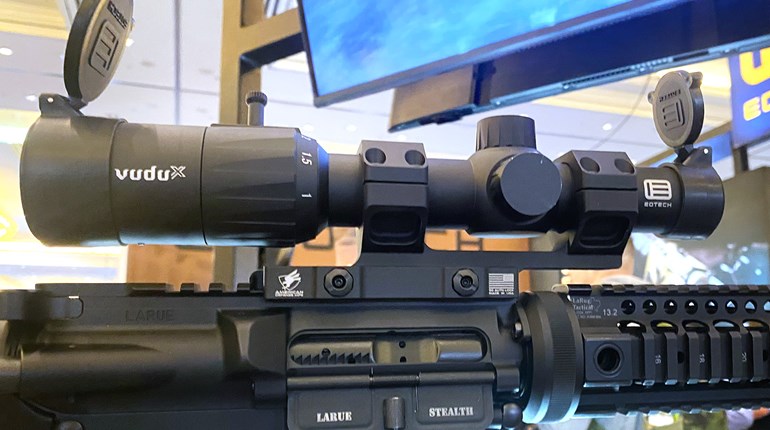
I’d wager not many can remember back before the classic 3X-9X scope became the hands-down favorite of hunters. He’s a familiar fellow: slender build on a 1-inch tube with a front lens topping out at about 40mm; simple, single crosshair, perhaps with thicker plex sections on some of the posts; low-rise adjustment turrets; low mounting over the action. No batteries or switches. Tough, dependable, capable throughout legal shooting hours. Affordable.
And now virtually antiquated in contrast to the techno-wonders flooding the marketplace.
Depending on how closely you follow such developments, you may or may not be surprised to learn that while the just-enough/not-too-much 3X-9X remains the top seller, industry insiders agree its margin is falling fast. The reasons for the plunge can be tied to two factors. The War on Terror unleashed a wave of innovation in optical and digital rifle sights in support of our military sharpshooters, and thus inspired a new generation of riflemen to emulate their skills and gear. This ripple effect is now seen in the growing interest in long-range hunting and in night-vision devices to hunt feral hogs and predators after dark.
Concurrently, an ingenious breakthrough in variable magnification occurred that reset what we can reasonably expect from a riflescope.
Herein we’ll sort out what’s truly useful in this time of rapid change, and take a look at emerging products that could have a profound effect on hunting optics in the near future.
Breaking Zoom-Ratio Barriers
Prior to Swarovski’s 2007 introduction of its Z6 (6X) line, riflescopes were stuck in magnification limbo. Scopes with 1-inch main tubes delivered maximum zoom of 3X (i.e., 3X-9X, 6.5X-20X), whereas those built on 30mm tubes were limited to 4X gain (3X-12X, 6X-24X). In part the limiting factor was how to coordinate movement of a pair of lenses located midway in what is called the “erector tube,” while also moving them independently of one another. To increase magnification these lenses track rearward toward the eyepiece; to decrease they go back toward the turrets. After much effort, Swarovski engineers devised a new trackway along which the two lenses move, and though in the same direction, at significantly different rates. Equally critical within this complex assembly was maintaining the precise tolerances needed to deliver full optical quality.
Swarovski’s new math triggered a magnification space-race, which, for now, has reset the max-zoom bar as follows: 1-inch—5X; 30mm—8X; 34mm—10X. Imitation being the sincerest form of market correction, most scope makers have followed Swarovski’s lead, and variables can now be found in nearly any zoom ratio you can name.
Tempting as it might be to wield a powerhouse 4X-32X or 5X-50X, I gravitated to the low end of the scale, looking for a scope to fit my personal hunting interests, which don’t require extreme long-range magnification but must be relatively compact and able to pivot between a wide field of view (FOV) and a moderate amount of zoom. In fact there’s no shortage of these since that’s the basic description for today’s tactical-rifle glass. However, the one I’ve been testing—the Swarovski Z8i 1.7X-13.3X pictured here—pulls duty on magnum bolt-actions.
For me, it’s a serious contender for top all-around practical hunting scope, just like the 3X-9X was when I bought my first one 30-some years ago. At both magnification extremes—the low end maximizing FOV for close encounters involving really thick cover, moving game, dangerous game or any combination thereof; high zoom for long shots, small game and low-light conditions—this poster boy has exactly what it takes: 40 percent more magnification than the 3X-9X, plus a generous 76-foot FOV at 100 yards on 1.7X.
Another valuable tool is the Z8i’s illuminated reticle that comes in seven different patterns, all with a center red dot. I especially like the separate day and night brightness options, easily selected via a topside toggle, for a total of 64 different illumination levels. And great as the mechanical functions are, the optical quality is even better.
The first time out, I kept the zoom and reticle brightness mostly maxed out while pursuing deer in northern California’s wide-open grasslands. But not so on a recent Alaska bear hunt. Multiple times, including once when a mature boar paralleled our retreat from about 30 yards, I dialed all the way down in the unlikely event he came busting our way. And since we hunted late into the extended northern twilight, I rotated through reticle brightness options too. When I shot my brown bear at 9 p.m., the scope was set on 6X with a low daylight illumination.
By today’s standards the Z8i’s upper-end magnification is pretty modest, but for practicality, size matters a lot—just as it did back when 1-inch-tube 3X-9X compacts with 28-32mm objectives came in around 15 ounces and barely sat higher than iron sights. At 22 ounces, my new pet scope, with its 30mm tube and 42mm objective, is bulkier, but still svelte compared to the long-range behemoths some guys lug around the mountains.
The Z8i won’t serve everyone as well as it has served me—there are more specialized models, for sure. In the same category, but less expensive than the Swarovski ($3,354 MSRP), are numerous makes/models offering a similar balance of zoom range, FOV and compactness. If you’re an old 3X-9X guy looking to upgrade, this is where you ought to start.
Thermal Vision
The setup was perfect: wind in our faces; silent stalking over short, damp grass; no way the pigs could see us coming under the moonless sky. But then something big rustled underfoot and splashed into the adjacent creek. “Gator!” mouthed guide Dan Braman. Night-blind as our quarry, my partners and I never saw it.
But Dan did and, equipped with the right tool, he could see those hogs we were stalking, too. That tool was something new from Trijicon, the handheld IR-Patrol thermal monocular.
“Come on,” said Dan, “pigs are still there.” We followed another 40 yards until he stopped. “Get ready.” I shouldered my rifle—now I could see them, thanks to its thermal IR-Hunter scope, also from Trijicon’s Electro Optics (trijiconeo.com) brand. The hogs were rendered flat black in contrast to surrounding shades of gray, indicative of the various “heat signatures” transmitted via the thermal units’ sensors. Every object was surprisingly detailed and self-evident, as if seen in fine black-and-white photography. My scope’s white reticle shifted onto one large hog’s shoulder, and on the count of “three,” we loosed some hunter-based conservation, South Texas style.
Thermal optics have begun to attract users who aren’t special operators, and many hunters probably don’t know what to make of them. However, it makes sense that Trijicon would bring this technology to civilian shooters, just as the company has bridged the military-commercial gap with riflescopes and reflex sights whose battlefield ruggedness and performance are prized no matter the mission.
Determined to lead the way again, Trijicon acquired highly regarded defense contractor IR Defense, including its patents, R&D and factory. As with most Trijicon products, this gear is all U.S.-manufactured, with three rifle-mounted lines, namely the IR-Hunter, Reap-IR and Snipe-IR.
Competition in this emerging market space means options in pricing and quality, but newcomers also have a lot to learn. In essence, a thermal sight is a highly specialized digital camera whose front lens transmits emitted heat waves to a sensor, which then translates incoming heat into a coherent sight picture. While there are many components and considerations, I’ve learned about three key specs that affect imaging quality and product reliability.
■ The sensor core is studded with detectors, and more is better. While standard detectors measure 17 microns, Trijicon IR optics use smaller 12-micron detectors, thus allowing a greater number packed tighter together. The result is 640x480 imagery, twice the 320x240 resolution yielded by 17-micron units.
■ Digital images “refresh” constantly, though at different rates depending on the processor. The IR units operate at 60hz (meaning they repaint 60 times per second) as opposed to a 25hz refresh in many competing products. This is especially critical when panning the rifle/scope, since with slower units, the sight picture you see when pulling the trigger may no longer be what’s actually happening.
■ Trijicon thermal scopes are built to MIL-STD-810G standards. Meaning, for military sales, they have proven capable of withstanding temperature extremes, rain, humidity, sand, dust, vibrations and shock in measurable testing.
There’s a learning curve to operating thermal gear, but after a few hours afield, the IR scopes’ thumbstick control made it easy to keep pace with the hog-culling action. I was a long way from mastering every function, but that’s true of all my digital devices. Having been reminded how fascinating it is to hunt after the sun goes down, it’s a skill-set I plan to work on.
Leupold Twilight Max
Now that optics firms have begun to tout the glass used in their lenses, effort is being made to educate buyers on the basics of light transmission. As a result hunters increasingly understand that light passing through glass splits into four curving color bands, which must then be rejoined at a precise focal point. If not, users are subjected to distortions that make images less distinct.
Leupold has taken a further step to reach educated customers with the introduction of its new Twilight Max Light Management System, which incorporates three co-dependent features.
First, the optical system is designed to perform consistently across the entire daylight spectrum rather than—as is often the goal—to transmit the maximum light possible. Light transmission through scopes designed for the latter spikes at midday, according to Leupold, whereas Twilight Max yields a flatter delivery curve resulting in more light early and late. Accordingly the system prioritizes red over green-blue tones, the better to see deer, elk and other big game at sunup and sundown. Leupold says it delivers more “usable light,” which translates to brighter, sharper images during optimum hunting times.
Twilight Max also reduces glare, light present in the scope but not involved in image transmission. This can occur when light is reflected at angles that cross the field of view, often seen as a kind of flare. Countermeasures include blackening lens edges that may catch and reflect light, and machining a thread-like contour on the main tube’s inner surface. Leupold’s Shane Meisel says these grooves act like “speed bumps” to trap errant light and thus lessen that “washed-out” look prevalent when we glass toward the sun low on the horizon.

The third element comes from the proprietary lens-coating’s ability to emphasize contrast and resolution important to hunters. By favoring red-yellow wavelengths, associated browns, tans and grays are more vivid, thus making it more likely we’ll spot big game in shadows and heavy cover.
For now, Twilight Max is offered in VX-3i, VX-5HD and VX-6HD scopes (leupold.com). While the integrated system is new, Meisel said that some aspects have been in use before and added, “We don’t necessarily look on this as new technology—it’s actually tribal knowledge that comes from building scopes for 70 years.”
SIG Optics LevelPlex—Canting a scoped rifle compromises accuracy, and so long-range shooters are turning to devices that help ensure their rifles remain level. Mostly these are small spirit (bubble) levels clamped onto the scope tube or incorporated into the rear mount/ring, which require users to shift attention outside the scope. If one is scrupulous about indexing every shot, it means repeatedly shifting focus back and forth.
SIG Optics (among others) has eliminated the need to look away from the FOV with its built-in LevelPlex, an illuminated reticle equipped with yellow indicators at both ends of the horizontal crosswire. When canted one way or the other, the corresponding arrow appears. When perfectly level, it’s dark.
Users can adjust the digital cant detection from .5- to 1.0-degree sensitivity, the latter proving most practical. I mounted the scope on two different rifles, firing two 5-shot benchrest groups at 300 yards, one with the LevelPlex (LVP) activated and another with it turned off.
■ Montana Rifle Co. X2 6XC: w/LVP 3.18", wo/LVP 3.78"; 15.8% advantage
■ Remington 700 SPS Tactical .308 Win.: w/LVP 2.82", wo/LVP 3.04"; 7.3% advantage
SIG offers LevelPlex in its Tango6 line (three models, sigsauer.com) with suggested pricing of $2,000-$3,000.
Smart Scopes—The past decade has brought rifle-mounted optics capable of measuring target distance, angle, weather conditions and more, data then used to calculate a “ballistic solution” for a given rifle/load pairing. Simply put, these “intelligent” scopes auto-adjust to existing conditions and provide the shooter a dead-on aiming point faster than he could dope the conditions himself. Smart scopes can also record live-action photos and video; and some can even share the sight picture via Internet hookup or relay it to the shooter’s phone and thus allow him to aim and fire without actually looking through the scope. While all of this technology was originally conceived for military application, most of these products are also being marketed to hunters.
An important distinction is that while some computerized scopes utilize optical-glass lenses, others are purely digital. They contain a sensor—the same core component used in digital cameras—that translates light into coherent images. Each type has certain advantages, too many to discuss here at length, but to single out key points for me, it would be the durability of optical systems vs. the potential for modification on the digital side.
Most popular is the Burris Eliminator series, whose on-board laser rangefinder corrects elevation for the subject just ranged, based on load ballistics programmed into the unit. The boxy original was a heavy tote in gamelands, but nonetheless won fans with its ability to present a zeroed, illuminated dot at the push of a button—no holdover or need to switch to an alternate crosshair.
Two iterations later, today’s Eliminator III also integrates an inclinometer to measure and correct for angled trajectories, as well as a wind hold-off function that indicates with reticle dots how far into the wind one must hold for a 10-mph value. Though its weight remains about 30 ounces, the Burris unit can be found in the high country, where its combo functions are most valuable.
More smart scopes are in development, by both leading brands and startup firms, and it will be interesting to see what they’ll “think of” next. We can count on further attempts to read and correct for wind. By working in tandem with the computing power of a smartphone, who knows what might be possible? How about an app that judges trophy quality? Or a GPS-connected video replay showing exactly where a deer or bear vanished into cover? Tech-savvy readers can likely dream up others, but what also remains to be seen is how much “assistance” hunters will accept and how much they are willing to pay.





































